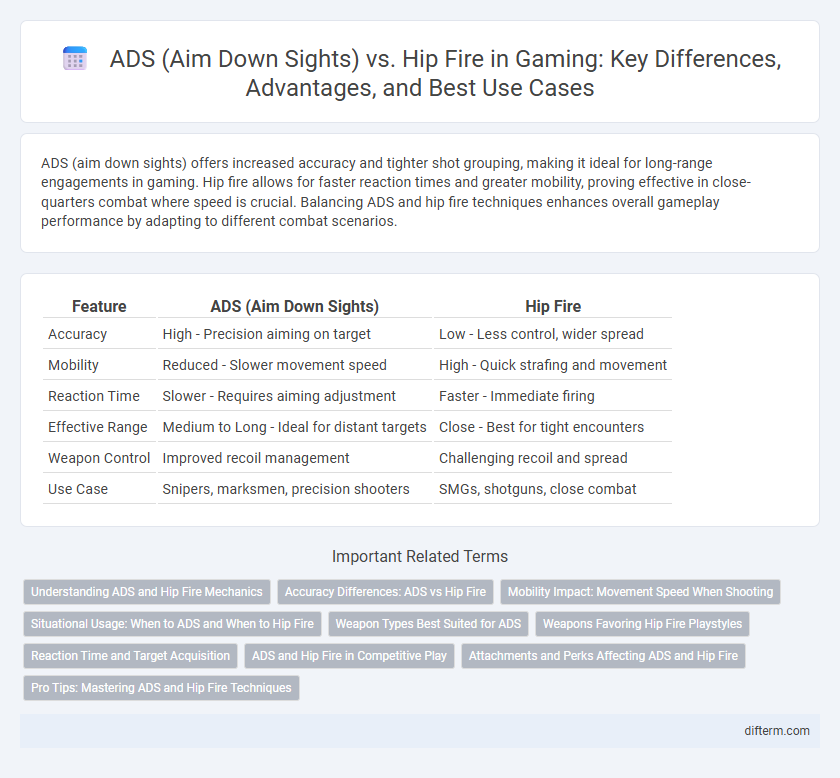ADS (aim down sights) offers increased accuracy and tighter shot grouping, making it ideal for long-range engagements in gaming. Hip fire allows for faster reaction times and greater mobility, proving effective in close-quarters combat where speed is crucial. Balancing ADS and hip fire techniques enhances overall gameplay performance by adapting to different combat scenarios.
Table of Comparison
| Feature | ADS (Aim Down Sights) | Hip Fire |
|---|---|---|
| Accuracy | High - Precision aiming on target | Low - Less control, wider spread |
| Mobility | Reduced - Slower movement speed | High - Quick strafing and movement |
| Reaction Time | Slower - Requires aiming adjustment | Faster - Immediate firing |
| Effective Range | Medium to Long - Ideal for distant targets | Close - Best for tight encounters |
| Weapon Control | Improved recoil management | Challenging recoil and spread |
| Use Case | Snipers, marksmen, precision shooters | SMGs, shotguns, close combat |
Understanding ADS and Hip Fire Mechanics
Aim Down Sights (ADS) improves accuracy by narrowing the weapon's sight picture, reducing bullet spread and recoil for precise targeting in first-person shooters. Hip fire offers faster movement and quicker reaction times by allowing players to shoot without aiming, but sacrifices accuracy and effective range. Mastering the balance between ADS and hip fire mechanics is essential for adapting to different combat situations and optimizing gameplay performance.
Accuracy Differences: ADS vs Hip Fire
Aim Down Sights (ADS) offers significantly higher accuracy compared to hip fire by reducing weapon spread and increasing target precision, especially in mid to long-range engagements. Hip fire provides faster movement and immediate shooting capability but suffers from greater bullet spread and decreased hit probability due to lack of precise aiming. Players prioritize ADS for accuracy-critical shots, while hip fire is preferred in close-quarters combat for speed and mobility.
Mobility Impact: Movement Speed When Shooting
ADS (Aim Down Sights) significantly reduces player movement speed, limiting mobility and making it harder to reposition quickly during engagements. Hip fire allows for faster movement while shooting, granting players greater agility and the ability to strafe effectively. Balancing ADS precision with hip fire mobility is crucial for maintaining optimal combat effectiveness in fast-paced gaming scenarios.
Situational Usage: When to ADS and When to Hip Fire
ADS (aim down sights) improves accuracy and precision for long-range engagements, making it ideal for targeting distant enemies or when navigating tight corridors requiring careful aiming. Hip fire allows faster movement and quicker reaction times, suited for close-quarters combat or situations demanding rapid target acquisition without sacrificing mobility. Effective players switch between ADS for precision shooting and hip fire for aggressive, close-range encounters to maximize versatility and response speed in varied gaming scenarios.
Weapon Types Best Suited for ADS
Precision weapons like sniper rifles and assault rifles excel with ADS due to their high accuracy and range, maximizing target engagement effectiveness. Submachine guns and shotguns generally perform better with hip fire because of their close-quarter combat focus and rapid fire rate. Tactical players prioritize ADS for long-distance eliminations, leveraging weapon optics and stability to ensure careful shot placement.
Weapons Favoring Hip Fire Playstyles
Weapons favoring hip fire playstyles excel in close-quarters combat, offering rapid target acquisition without the need for precise aiming typically required in ADS (aim down sights). Shotguns and submachine guns (SMGs) often feature high hip fire accuracy and faster movement speed, making them ideal for aggressive, fast-paced engagements. Gamers prioritize these weapons in tight maps or situations demanding quick reaction times where ADS can hinder mobility and reflexive shooting.
Reaction Time and Target Acquisition
Aiming down sights (ADS) significantly improves target acquisition accuracy by narrowing the field of view and enhancing precision, but it increases reaction time due to the animation delay and reduced peripheral awareness. In contrast, hip fire offers faster reaction time by allowing immediate shooting without aiming animations, yet it sacrifices accuracy and effective range. Competitive gamers often balance ADS and hip fire based on the situation, prioritizing quick reaction in close quarters and precise target acquisition at longer distances.
ADS and Hip Fire in Competitive Play
Aim Down Sights (ADS) provides higher accuracy and precision in competitive gaming, enabling players to engage targets at longer distances with improved shot placement. Hip fire excels in close-quarters combat due to faster mobility and quicker reaction times, allowing players to maintain agility while firing. Mastery of both ADS and hip fire techniques is crucial for competitive play, as switching between the two based on range and scenario can maximize effectiveness and kill potential.
Attachments and Perks Affecting ADS and Hip Fire
Attachments like laser sights, foregrips, and barrel stabilizers significantly improve hip fire accuracy by reducing spread and recoil, enhancing close-quarters combat effectiveness. Perks such as Sleight of Hand and Focus reduce ADS aiming time and sway, allowing faster target acquisition and sustained accuracy during prolonged aiming. Combining specific attachments with perks tailored to either ADS or hip fire optimizes weapon performance for various combat scenarios in gaming.
Pro Tips: Mastering ADS and Hip Fire Techniques
Mastering ADS and hip fire techniques enhances precision and reaction time in fast-paced gaming environments. ADS provides superior accuracy for long-range engagements, while hip fire allows quick target acquisition during close-quarters combat. Balancing both methods with consistent practice and equipment sensitivity adjustments significantly improves overall shooting performance.
ADS (aim down sights) vs hip fire Infographic

 difterm.com
difterm.com